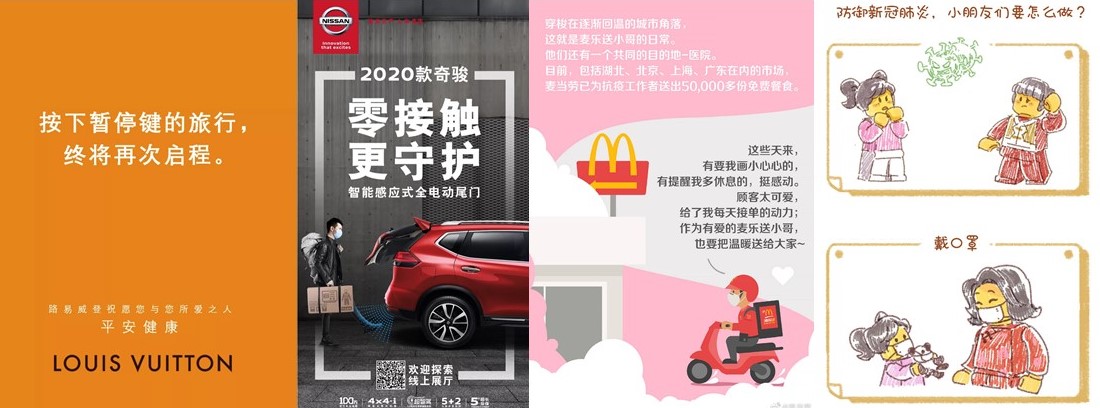Are American Brands Prepared for the Coronavirus Pandemic? Lessons in China Offer Tips
The coronavirus (COVID-19) is spreading around the world and threatening the global economy. By February 26th, there have been 59 confirmed cases In the U.S. and the number is expected to increase sharply. “It’s not so much a question of if this will happen anymore but rather more a question of exactly when,” warned CDC officials, speaking to the pressing urgency of the situation.
For American corporate brands, it is critically important to react quickly and prepare solutions in coping with a potentially unprecedented scale of panic and business shutting down. During times of crisis like this, it’s the responsibility of brands to demonstrate solidarity and support towards the public while adjusting business strategy to survive.
How global and local brands in China have been adopting provide us inspiration and ideas.
As the center of the outbreak, China is the first to practice large scale city lockdown, and businesses, especially retail industries, have been severely impacted. In crisis management mode, brands are swiftly developing campaigns and cross-channel integrations to reassure their audiences and provide convenient shopping options much needed in the self-quarantine life.
Show Support and Sympathy
Since the last week of January, hundreds of millions of Chinese have been staying at home and waiting, with both patience and anxiety, for the “tipping point” to come. The outbreak has pressed a “pause and reflect” button for Chinese. While news headlines focus on the virus development, posts about keeping faith, self-reflection and eco-consciousness have skyrocketed on Weibo and WeChat, the two largest social media platforms in China.
Addressing this crowd sentiment, a breadth of brands have rolled out campaigns, with their brand DNA, product or service integrated, to express support and sympathy and take actions to help fight the virus.
Louis Vuitton put up a post on its official WeChat account “Every paused journey will eventually resume. Louis Vuitton wishes you and your loved ones safe and healthy.” It is a simple yet heart-warming, aspirational message, and true to the brand’s tonality and its roots as a fine travel luggage producer.
There are also interesting cases on highlighting product features that fit practical purpose in this particular situation. Nissan featured its Motion-activated Liftgate with a headline “Zero Touch, Better Care” to address the public anxiety over virus transmission and contextualize the brand’s human-centered technology into a highly relevant real-life scenario.
Besides financial donations, lots of brands are tailoring their business offerings to help the community. McDonald’s, for example, has deployed a special task force team that “Sends a little warmth to everyone” and delivered over 50,000 free meals to doctors and nurses on the front lines.
There is a strong sense of helping each other among the public too. LEGO recently posted a children education illustration series that uses LEGO pieces and characters to tell the story about the virus prevention. It was created by a LEGO employee during her quarantine time at home and has gone viral online.
Offer Convenient Shopping Experience through Cross-channel Integration
Retail businesses in China, including shopping malls, theaters, restaurants, car dealers, parks, museums, etc., either have to significantly shorten their operating hours or completely close down during the quarantine. Meanwhile, even though people are mostly stuck at home, there is still desire for shopping, and the desire actually grows stronger after weeks of remaining indoors.
So many have turned their attention to online. Online shopping has become a way to fight boredom and keep up the spirit, and demand for some particular categories like health and wellness, entertainment, video gaming and beauty products are increasing.
The situation has urged brands to integrate retail business with virtual online experience to enable consumer connection and generate sales. Thanks to the well-developed social commerce ecosystem in China, people can now enjoy VR shopping and make purchases easily with WeChat Pay or Alipay, the two dominant mobile payment systems in the country.
Mixc, a high-end shopping mall in Shanghai, developed a VR mini program on WeChat that allows people to browse products from individual shops and counters inside the mall; from skincare and jewelry to grocery and baby care, and make instant purchases. This outbreak has, in a way, accelerated the development process of the concept “New Retail” in China as an increasing number of brands integrate offline and online businesses to create omni-channel experiences for consumers.
Interestingly, even big-ticket items like auto and real estate are jumping onto the bandwagon.
BMW’s official WeChat account has recently launched a mini program that allows people to take video tours of the cars they like and chat with sales representatives in their preferred dealer locations while browsing the dealer’s inventory in real time. This well-received novel experience has the potential to revolutionize the car selling model as over 50% of Chinese car buyers think online car shopping helps them save time and cost, according to a recent survey pulled by Dataway, a Chinese research firm.
Evergrande Real Estate Group, China’s second-largest property developer by sales, launched an unprecedented online sales campaign on February 13th. Through VR experience, people can have a view on practically everything in the property – outdoor garden, building façade, model unit, amenities and sales office. Within only three days, the company had sold over 47,000 units nationwide with a total of $8.2 billion sales.
Cross-channel integration and enrichment of online shopping experiences clearly help revitalize businesses in China during this tough time, and many business executives have recognized that this shift is not simply a response to the virus outbreak, but a long-term strategic implementation.
Now, the tables turn to business in America. Brands can learn from the experiences of their Chinese counterparts and adjust to the new realities. We are a global community, and in the midst of this pandemic, we as members of that community should be building bridges and learning from one another to see us out safely on the other side – together.
Written by Selina Guo
Planning Director
selinag@admerasia.com







